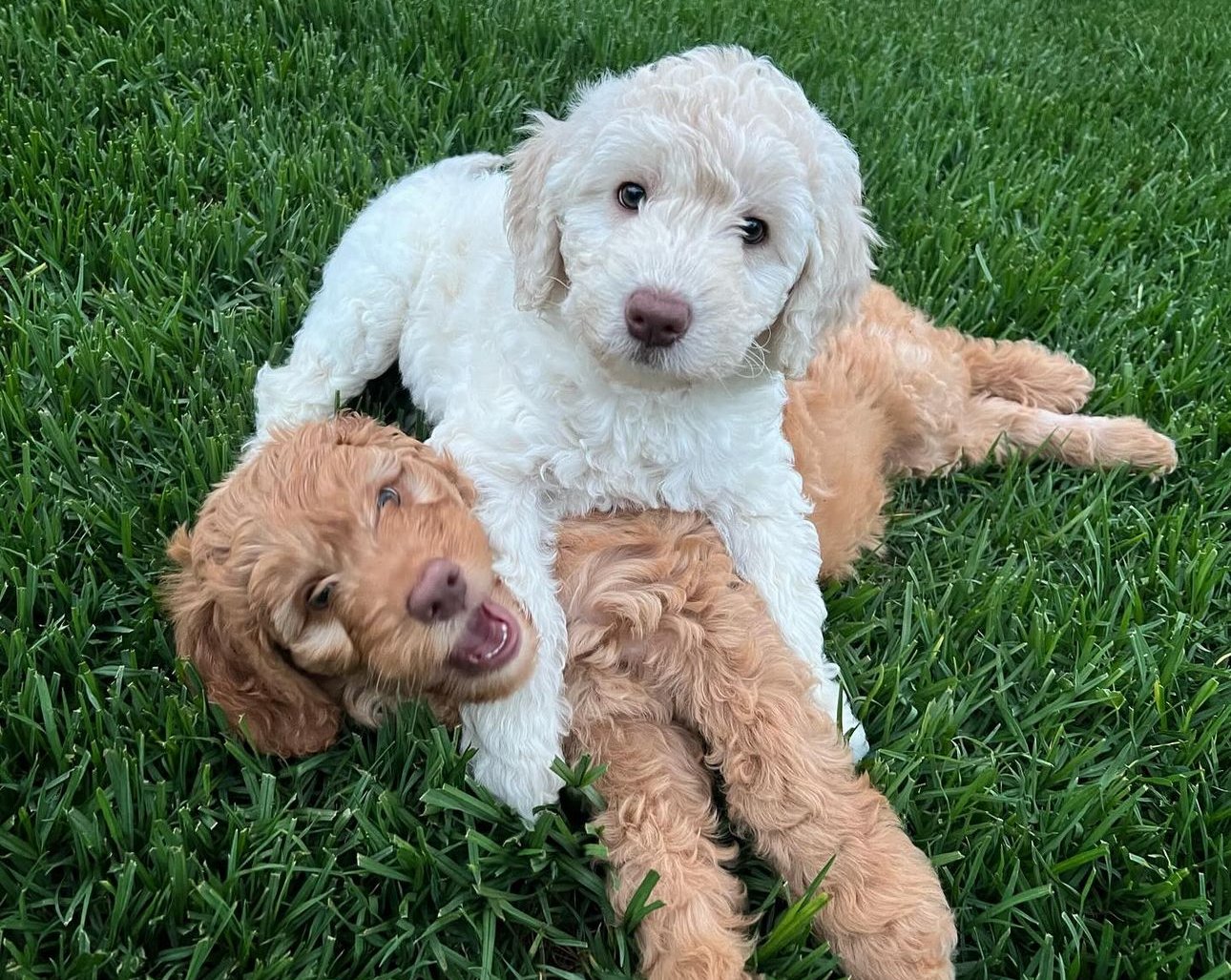Coat Types.
One of the most common questions we get asked is the differences between wool and fleece coats.
DNA research can provide us with information regarding how coat genes affect the “look” of a Groodle. Selecting for genetic traits is a much more reliable indicator for appearance and shedding intensity rather than using a specific generation for breeding (GANA, 2024).
-

Straight Fleece
GRANOLA
Granola has no copies of curl in her DNA, meaning she has the “shaggy” straight coat. Granola lives her best life in the Northern suburbs of Sydney.
-

Wavy Fleece
HONEY
Honey has one copy of curl in her DNA, resulting in a luxurious wavy coat.
She definitely uses conditioner. -

Straight Fleece
MILO
Milo also has no copies of curl in his DNA, and has the straight soft fleece coat.
He is a beautiful chocolate boy.
-

Curly (wool)
MOLLY
Molly carries two copies of curl in her DNA, meaning she has tight curls similar to a poodle. Here she is at 6 months.
-

Curly (wool)
ELVIS
Elvis showing us what his wool coat looks like at approximately 7 months.
Yes Elvis, we see how proud you are of your hat. -

Curly (wool)
DOLLY
Miss Dolly’s beautiful wool coat at 18months of age.
Dolly is one of our mummies to our Ultra puppies.
FAQs
What are furnishings?
Furnishings are longer facial hair including eyebrows, mustache, and beard found on most Groodles. Golden Retrievers have an “open face” that has short facial hair, sometimes also known as a flat coat (GANA, 2024). When people ask us for the “teddy bear” look, we know they are referring to the double furnished look that you can see in all our photos above.
Although most owners prefer Groodles with furnishings, some really enjoy a goldendoodle with a flat coat. These dogs tend to shed less than a purebred Golden Retriever and require less coat maintenance (GANA, 2024).
Which coat sheds less?
Fully furnished groodles should not noticably shed - there should be no hair on your furniture, or clothing. As long as the dog is fully furnished, it should make no difference whether the dog is fleece or wool in terms of shedding.
Groodles are known as ‘hypoallergenic’ and often have a low-shedding coat. This can be advantageous for individuals or families with allergies to dogs. However, it is important to understand what hypoallergenic truly means. The term hypoallergenic is composed of the root words ‘hypo,’ which means less, and ‘allergenic,’ which means the ability to induce an allergic reaction.
What if I have allergies?
This will depend on whether you are allergic to dander (hair) or saliva.
Hypoallergenic is a layman’s term used to suggest that the majority of people who experience allergies to dogs will not be allergic to dog breeds with a specific coat type. Allergies are very intricate and individualised to the person who experiences them. This is why breeders cannot 100% guarantee that someone who is allergic to dogs will not have an allergic response to Groodles.
A Groodle with two furnishings alleles cannot guarantee that you will not be allergic to a particular dog. Allergies are very complex and shedding is just one of the components that factor into the equation. Consider that dander, saliva, proteins, and allergens carried on the dogs coat can all contribute to each individual’s allergic reaction. If you have a family with allergies, a Groodle with a flat coat (unfurnished) is not the best match for you - look for a fully furnished Groodle instead.
What grooming do Groodles need?
Most people are drawn to a groodle as they resemble a teddy bear. Unlike teddy bears though, you cannot just throw them in the wash when they get dirty and leave them to dry!
The softness of the groodle coat means you need to brush your pup regularly to avoid their coat matting. Matting is painful for your dog and easily avoidable. When you first get your puppy, get them used to regular brushing and handling, including nail clipping by offering lots of rewards and treats during your grooming, making this a pleasurable experience for your pooch. During the summer months, it can be more comfortable for your groodle to have regular 4-6 weekly grooms as groodles don’t tend to tolerate high heat very well. During winter many owners opt to let their groodle’s hair grow longer to keep them warm, moving to 8-10 weeks between grooms. However, be mindful that the longer your groodle’s hair goes between grooms, the more important it will be to have a regular brush to avoid matting and potentially being cut very short at the next groom.
“A dog is one of the few things in life that is exactly what it seems”
— Source Unknown





